Ancient Swedish Elkhounds
Ancestors of Takoda A Long Time Past
What is clearly evident from this photo of the Swedish dogs are the leaner longer body styles, the lighter lower chests and muzzles, and loose curl to the tails.
A Big Registered Swedish Elkhound
Male, Rico, shown with his handler, Beth!
This big fella, Rico is a 'JAMTHUND" , his ancestors went into the registration process, and he is a full blooded Swedish Elkhound. Beth and Russ are excited to work with us in having a litter with Rico and Aina. We are planning that for the spring 2018. Click here for the details: Swedish Elkhound Pups
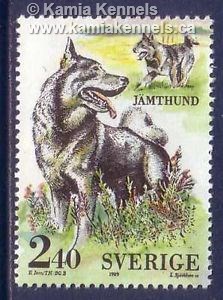
I found this old stamp some how and find it amazing how the artist was able to successfully render the exact style of this particular dog.
Takoda Just Over 7 Years
Desna 12 Weeks
Takoda sits here with his young son Desna. He is just over 7 years old in the image.
Aina - our beautiful Swedish Elkhound, Jamthund female. She is just over a year of age in this image spring 2017. You can learn more about her here: Aina Swedish Elkhound
I will cover some of the old world breeding principles that we follow here at Kamia Kennels.
Two Ancient Swedish Elkhounds Hunting Moose - Basically Unchanged Today At Kamia Kennels
The photo to the left is of two ancient big Swedish Elkhounds out hunting. You can see the typical
behavior illustrated clearly, the barking, circling around in the face of the Moose, keeping it busy and doing enough to stall it and hold it steady in an area while the hunter catches up.
The tighter coats are easily recognized and for the most part, those two boys in that photo could be from the same litter as Takoda. They are practically identical. If Takoda ran into that opening in the forest with them they would all look to be brothers.
The goal of our program is not to change the breed, we want to breed the working dog of centuries past. Those ancient Swedish Elkhounds were bred for the deeper snow regions, bred to do exactly what they are doing here and are a flawless example of efficiency and breeding acumen. These my friends are deep snow Elkhounds.
What I want to be clear on is that ancient Swedish Elkhounds like these two boys in the photo above later became the foundation for the Jamthunds. Ancient Swedish Elkhounds were just that for centuries, Swedish Elkhounds. They were a type of Elkhound bred for the deeper snow and bog regions and used primarily for all purpose hiking and hunting dogs. They were guardians of the home territory, spent life with a handler watching and hiking with him. Always on the alert to danger and making sure that the trails they traveled were safe for the handler. These are the bear hunting Elkhound dogs, many were used to hunt bear, and still are today. These are fearless dogs, they have a different style and composure than the Norway type.
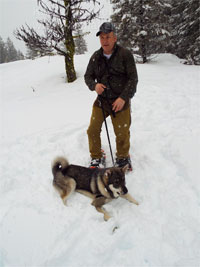
( I am shown to the right below with Rico a magnificent Jamthund Male. We will be having a litter from him and Aina this spring 2018)
These dogs are still bred in many parts of the world exactly as they were for centuries. Not all of the Swedish Elkhounds went into the "Jamthund" program. Although today, in Sweden, the Jamthund is officially the Swedish Elkhound. All of the magnificent males and females they could muster up in the 1940 - 1950 time frames were brought forward to supply the original breeding base for the dogs that exist today in the "Registered Jamthund Organization". Canada is a ways behind the rest of the World in relation to the Swedish Elkhound as Canada does not recognize the Swedish Elkhound or Jamthund as a separate breed as such, so no registration exists in Canada for this type.
Takoda is a perfect example today of what all those breeders were striving for when raising good dogs. They wanted a free and easy moving big fella, fearless in nature, able to bond with the handler and tons of independent skill. The breed for centuries has been honed to finite edge that all traits are useable traits. These are working dogs, yes, very suitable for families and acreage life, well suited to hiking and active lifestyles of today, but still underlying all the great benefits of this dog is the ability to work.
I will take some time in this article to cover the reasons why I feel the Ancient Swedish Elkhounds are one of the very best, if not THE BEST dog for an active family in Canada today. But first, I will discuss some of the characteristics and style of the bigger Elkhounds. One thing before I get to far along is that the dog is bred not to be "Aggressive" to the Moose. They should harass a bit, keep them pro-occupied, but not become aggressive so as to move them off and get them moving away. Lot's of folks don't realize that the Elkhounds are not going to "Chase" as such, they will get around in front and entice and keep them busy. They will wander along with the Moose as it moves along.
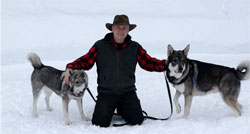 One of the features about the Swedish Elkhound of course that sets them apart from the Norwegian types is the size. They are almost always taller and longer. They don't always have to be heavier, but with the extra length and height comes some additional weight. Very much the same ideals were sought in these dogs pertaining to the agility, the balance and the performance of the dogs but a few things over centuries set them apart. They have a very free easy movement with the longer reach. Covering ground like few other dogs can the Swedish types excel at vast ranges. Put this extra reach and height into some deeper snow and it makes for a much safer hunt, they have the ability to move and dodge in deeper conditions, yet remain fully agile and fast.
One of the features about the Swedish Elkhound of course that sets them apart from the Norwegian types is the size. They are almost always taller and longer. They don't always have to be heavier, but with the extra length and height comes some additional weight. Very much the same ideals were sought in these dogs pertaining to the agility, the balance and the performance of the dogs but a few things over centuries set them apart. They have a very free easy movement with the longer reach. Covering ground like few other dogs can the Swedish types excel at vast ranges. Put this extra reach and height into some deeper snow and it makes for a much safer hunt, they have the ability to move and dodge in deeper conditions, yet remain fully agile and fast.
Some serious stamina comes with the big deep long chests, these boys can run for days, in the northern Siberian ranges they have been known to cover 100 kilometers in the dead of winter on frozen lakes, and ready to go the next day. Double coat dogs, no odour, a superb species well suited to the Northern regions.
This big fella Rico, shown at the left with Beth is the same dog as the three above him, however because his ancestors moved into the program association he is what is referred to as a Jamthund. The Jamthund is the National Dog of Sweden. We don't refer to Takoda as a Jamthund, only a Swedish Elkhound.
One thing that the Swedish Elkhound has in looks outside of the size and length is a predominate white/yellow lighter colored lower jaw throat area and the black comes down from the muzzle/eye area into this lighter area as if it was tying the mask on. There are varying degrees of difference in that aspect, but one thing is certain its readily visible from early on.
Desna has a large northern Norway mother, GAEDA. GAEDA has deep in her background some northern Swedish blood, thus the reason that white throat and mask tye comes out so easily. It's one of the main things that the big Swedish dogs stamp onto their pups.
Desna has the much lighter chest as well and the top coat on him will come in with the longer guard hairs as he matures, he is only 16 weeks or so in this photo and is a tremendous young fella. All the traits of the old Swedish boys are in his behavior, his style and movement. Personality wise he brings all the very best forward as well, the Swedish dogs are so personable to the handler, and basically are never stubborn, recall is superior to virtually any breed.
Desna will end up maturing out almost exactly like the big Jamthund above him. He will be in the top end of the size and weight, he will mature out around 70 lbs pounds and will be 24 inches or so tall.
"This is a quick update on Desna - I wrote the article almost a year ago, but have a recent image of Desna that Tim sent me as of December 29th, 2015 - Desna is as I imagined, over 24 inches tall, and over 70 lbs, he will gain more muscle and weight than where he is at today. I also mentioned the goal with the ancient Elkhound is not to harass the Moose, and I think from the photo you can get the idea that Desna has a pretty good handle on how to not harass the moose. You can't get any better than that! Thank you to Tim and family for keeping us posted on Desna! "
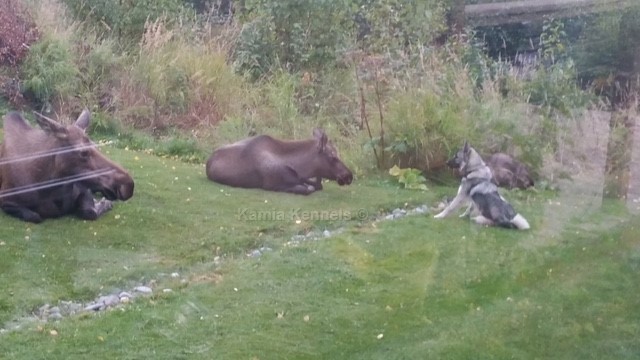
Another trait about the Swedish type that is fairly predominate is the difference in the coat. They have a much longer black end on the guard coat and it leaves them looking much darker overall, and when they shade into full coat in the winter can turn very black. The black runs much further down the front legs and further down the back legs as well. It's a tighter coat for the most part also. I find that Takoda is the very first dog to start losing the inner coat each spring. He will begin to show the inner coat coming out before the others.
During the year he rarely loses any and other than the spring and the little bit in the fall, he is basically a dream to manage for that aspect. We find that for the most part his coat requires very little maintenance, none of the others require much either, but as long as you brush out that inner coat in the spring you have it made. I have all black vehicles, black carpet etc. and transport all my dogs all over, I have very little hair visible at any one time, I think it's hardly
noticeable.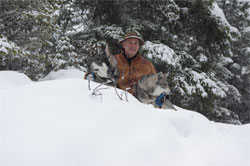
People that say they shed heavily, or lose a lot of hair, I am not sure what they are feeding and or doing, as all of mine don't do that. I don't find it very bad at all really, and I have a lot of dogs of course. I can give Takoda a brand new dark rug to lay on and weeks can go by and it's still looking like new, it's not full of hair like some folks write. Now, I am not suggesting that anyone writing some of the information on Elkhounds these days have one, but some places do mention this about the Elkhound and I wanted to lay that to rest. I do NOT see the coat as any issue period. Takoda looks fabulous anytime of year with basically a brushing or two a year. He has never had a bath, and has never been clipped or trimmed etc. No nails have been cut, nothing.
Takoda has a very dominant personality, especially towards other dogs.
That one trait in my opinion is a good thing, not something one would shy away from. I like dominant dogs as in my opinion they have less trouble than non dominant apprehensive dogs. A good fearless dominant dog can enter a wider range of situations with more composure and more ability in my opinion. The Swedish type has that running throughout for the most part.
These are very good dogs for such a wide range of circumstances, and also, back to my opinion, I find that a confident dominant dog can make decisions on his own faster, and closer to the traits and instincts he was bred for, especially in critical times, like threat situations. I of course use my dogs as a primary warning mechanism in hiking remote regions so I rely, I trust my life in fact to this trait. I find it extremely valuable.
The photo of the Old Stamp of the Swedish Elkhounds
Whoever did this rendition was very familiar with this breed, spent a considerable amount of time around them and was able to relay that information into these two images.
That top right image of the gait and step of the big Swedish greys I have seen countless times, they have such a nice effortless reach and stride. The mouth open, happy to be cruising the trails and woodlands, ears up and to the sides a bit, catching all the sounds. The tail is loosely curled just a fun time that dog is having, you can just see it.
The other image I have seen thousands of times, only from the other angle, the angle of when the dog is looking back. that dog is looking at it's handler. The artist was able to render that image perfectly as well. This is a ranging dog, so they are always going to stop and wait for you, check back, make sure your moving along on your trail, they will be scouting around you. The artist was able to lay all that out on a simple stamp. I find that pretty cool indeed.
The photo of Takoda below the stamp
As you can see from this image, that artist who did that stamp above was pretty darn accurate, no doubt. Pretty neat isn't it?
Canada has a lot of terrain and regions that are very close to the Sweden, Norway, Finland area, across even to Russia and Siberian ranges. Our goal is to put our dogs into these types of areas regularly, gauge the abilities of the pups and offspring and watch that we are keeping traits intact.
I have now a granddaughter of Takoda's here with me, she of course is from Tora, Takoda's daughter, who is also here, and of course Jaegar his son is always around. So for me, it's easy to watch the traits pass down. This is a fairly critical part of raising dogs in my opinion. Without that close working knowledge of the offspring, and even more importantly the next generation after you would have to rely on feedback entirely. This would be fine for me of course, as all my folks are truly awesome at providing feedback and information on a regular basis. But still, having them here gives me that extra bit of information and exposure to witness the abilities, the skill, the working range.
I want to provide a new handler with a dog that is every bit as capable, and true to it's roots and instincts as possible. In some small way I consider myself to be kind of like the individual who did that stamp, I want to preserve, yet display and portray all the big Swedish Grey's can be. By working my big dogs in difficult situations, all types of terrains and environments, trying to allow them to bring forth all the abilities they have, I think this gives the Swedish Elkhounds a great opportunity here in Canada. I know they flourish in Sweden, and I know they are flourishing here. We have more Jamthund history here.
The photo of Takoda Swedish Elkhound Male, and his young son Desna
Takoda and Desna are watching the yard, some noise alerted them out at the end of the yard and they are both quite intent on checking it out. The old territorial instincts are front and center with these two.
Desna could go off leash with me, actually all of Takoda's pups can, but Desna would come as a young dog offleash for long mountain bush hikes all the time, never on a leash. He was here for the first ever starter training program I have begun, so he stayed for the 16 weeks for that. There is nothing like a big Swedish Male to watch the gate and share his technique with the young males. The ancient old stories about the keepers of the gate were always speaking of the Swedish Elkhounds. No strangers get to approach the gate they keep. Takoda takes his territory very seriously, he allows no intruders, two or four legs.
There are few dogs with the range of skill these dogs possess, and for the region and work and lifestyle that Canadians have, this is quite frankly the very best dog a Canadian could have. You can also check out our "Desna Training Program for Elkhound Pups".
These my friends are Ancient Swedish Elkhounds!
Takoda pictured below with me on an Elkhound Extreme Winter Hike February 2016 - Few breeds or dogs could follow him up here, there is no trail but what we make! He is just over 8 years old in the image directly below.
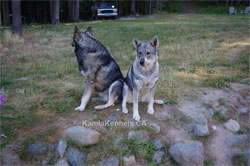 Aina
and Takoda in July of 2017. These two get along so well, they bonded the
minute Aina came home with me from Finland. She immediately formed a bond
with Takoda. He has become a great mentor to her. Funny how among all
the Elkhounds she and Takoda find each other as pals, knowing they both
have the old Swedish roots.
Aina
and Takoda in July of 2017. These two get along so well, they bonded the
minute Aina came home with me from Finland. She immediately formed a bond
with Takoda. He has become a great mentor to her. Funny how among all
the Elkhounds she and Takoda find each other as pals, knowing they both
have the old Swedish roots.
Aina will be having a litter in the early part of 2018 with Rico. We are very excited about that upcoming litter. Full details on the Jamthund Pups.
Copyright @ 2012 Kamia Kennels. All Rights Reserved.